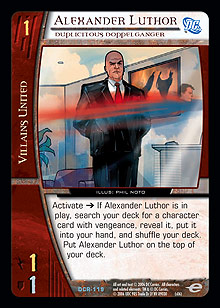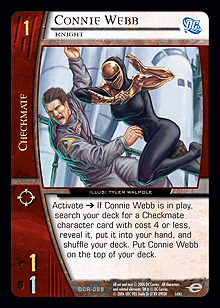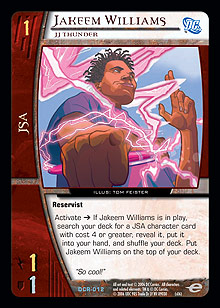
Welcome back for week three of Creating a Crisis. In the last two weeks, I discussed my design philosophy during Infinite Crisis, both from a mechanical and a thematic perspective. Both of those articles took a broad approach to understanding design. This week, I want to zoom in a little bit and take a look at one of the tools used during design: cycles.
A cycle is a series of cards that are linked to reinforce a theme. Each card in a cycle will share a mechanical element (and usually a thematic one as well), although it's the differences between these cards that make them interesting. Cycles are an integral part of the design process because they create and reinforce the structure that defines a set and the teams within it. Human beings inherently crave structure and order; when trying to sort through a new set of cards, cycles help players to focus on and tease out the inherent nature of each new team. One of the unique challenges of designing Vs. is that in each set, we create entirely new teams for the game. With the exception of reprint teams, we have to start from scratch in every set and define an entire team using less than fifty cards. Cycles help to define a team by contrasting its part of the cycle with those of other teams. Let’s take a look at some of the cycles in Infinite Crisis to help illustrate this point.
The Champions
Probably the most well-known cycle in Infinite Crisis is the Champion cycle.
The Champions spread through the four major teams; I talked about them in my first preview article. This cycle was originally inspired by the cycle of “champion” plot twists in The Avengers (though they were not referred to as champions). The idea of a card so powerful that it prevents you from playing any other plot twists in a turn is very exciting and lets us create some pretty cool effects. I wanted to replicate this in Infinite Crisis, but with a twist . . . though I did get a chance to pay homage to the original cycle with Fate Has Spoken.
Each Champion grants a powerful optional ability if you are willing to forgo plot twists on a critical turn of the game. Each Champion’s ability highlights a major theme of its team. By making these cards powerful and splashy, it forces players to take note of what each team does and helps to give definition to those teams in reference to the others in the set. By comparing these cards, players can learn that Shadowpact likes to be at low endurance, JSA likes to battle up the curve, Villains United is out for vengeance, and Checkmate starts out weak but gets stronger when working as a team.
The Searchers
Another popular four-card cycle in Infinite Crisis is the 1-drop “search” cycle.




Each of these characters puts him- or herself on the top of your deck in exchange for a specific card type. They highlight what a team cares about and the type of cards a team plans to use to win the game. Connie Webb and Jakeem Williams also provide a nice two-card “mirror” cycle highlighting the difference between a superhero team (which hopes to use individually powerful characters to win the game) and a spy network team (which hopes to use many small characters working together to win the game). Although this cycle is less splashy than the Champion cycle, it works very well because searching is such an important part of Vs. System. The ability to search consistently for a card type greatly reinforces any theme involving that type and encourages players to build decks highlighting those themes.
The Resource Payment Effects
This cycle is a little bit subtler than the previous two. It’s made up of seven cards, including five team-specific cards and two generics.
This cycle grew from a single card in the initial design file to the largest cycle in the set. Why is this cycle so large, and what purpose does it serve in the set? Hint: Notice the rarity of the cards.
One of the worst feelings in Vs. is missing a key character drop. This type of play experience can be frustrating, and very often it leaves you with no decisions to make during your recruit step. This problem is particularly pronounced in Sealed Pack and Draft play, where you often have very little control over your card pool. By creating a series of plot twists (and one location) that let you do something with unspent resource points, suddenly it isn’t the end of the world if you have to under-drop. These cards were carefully designed and developed so that they wouldn’t overshadow playing characters, but in Sealed Pack and Draft, they do a great job of acting as a comeback mechanism to help you win games you might otherwise have no chance to win. In addition, it is occasionally correct to under-drop intentionally in order to get access to a key effect like flight on a critical turn. Cycles like this are very exciting because they let us highlight team themes while simultaneously helping to smooth out the game engine.
The Hourmen
Up to this point, I have talked only about horizontal cycles. These cycles share a mechanical link from their costs but generate vastly different effects. The costs link the cards together and create structure, while the effects differentiate the cards and create thematic flavor. Another type of cycle is what I refer to as a vertical cycle. Vertical cycles are more strongly linked than horizontal cycles because they have both a linked cost and a linked effect. Where horizontal cycles use contrast to define thematics, vertical cycles use similarity. The best example of a vertical cycle in Infinite Crisis is the Hourman cycle.
The Hourman cycle reinforces what it means to be Hourman. The function of each Hourman helps to link these characters together and allowed us to make another card that could be both thematically and mechanically linked to this trio. I won’t list that card here, but I am sure that any of you who have spent some time looking at the Crisis set know which card I am talking about. The mechanical link provides a strong connection and points players toward a little Easter egg linking these four cards.
Some of you might be asking why this particular mechanic was chosen to represent Hourman. The ability to become incredibly strong for a short period of time makes a lot of sense, but why does he give your opponent endurance to do so? Answering this question will allow me to highlight another important structural element of Infinite Crisis. The original Hourman designs had a much more standard endurance payment to activate their effects. During playtesting, we noticed that this ability felt very strange, and eventually, Andrew Yip figured out why. Infinite Crisis defines what magic means in the Vs. System, and it does this by using endurance payments. The Hourmen were not magical, but they seemed to have too much thematic “bleed” into the Shadowpact magical theme. This led to a deep analysis of how each team should be interacting with endurance. Because Shadowpact was utilizing endurance in a way that no other team ever had, we decided that each other team should interact with endurance in a way that contrasted with the Shadowpact. This created a kind of super-cycle that formed a large part of the structure for the set. This change really helped to reinforce the feel of magic and ended up creating interesting dynamics for the other teams, as well.
The four primary ways to interact with endurance are gaining endurance, paying endurance, direct endurance loss, and giving your opponent endurance. Shadowpact had the monopoly on endurance payment. Villains United, as the resident bad guy team, became the candidate for direct endurance loss because, well, direct endurance loss just feels evil. In order to represent the conflict between the Secret Six and Villains United, the Six were given the counter to direct endurance loss: endurance gain. That left the JSA and Checkmate. Giving an opponent endurance seemed like the kind of thing a hero would do and certainly seemed out of place for Checkmate, so that part of the thematic pie was given to the JSA, and thus, the Hourmen were born.
That is about all the time I have for this week. There are many more cycles in Infinite Crisis that I will leave for you to find. The beauty of a cycle is that it helps your enjoyment of the set even if you don’t explicitly know about it. Our subconscious minds are incredibly good at forming patterns and seeing beauty in structure. The structure in every Vs. set gets reinforced in a lot of ways, be it through cycles, art, flavor, or recurring mechanical themes. Hopefully, this article has helped you to see some of the wheels turning behind the scenes.
Next week, we’ll take a look behind the curtain and learn the secrets of magic. As always, send in your questions and comments to Justin_Gary@upperdeck.com.